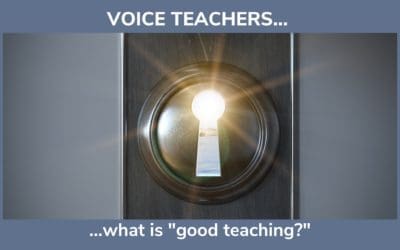Most everyone thinks: If I do more, I’ll get more. If I read more, I’ll learn more. If I exercise more, I’ll be able to perform more. If I practice a song more, I’ll know it better. If I sing more, I’ll sing better. This approach has an intuitive logic to it that seems obvious and unquestionable and so many people say that that’s what we SHOULD do that it seems weird to think that, actually, less is more.
But, it is. Doing less REALLY is the best way to get more… I promise.
Now, of course, there are some exceptions to this rule like if, for instance, your goal is to get physically stronger by building more muscle mass. Then, in that case, more strain gets you more muscle. But, that doesn’t necessarily make you stronger or better at doing the things you want to do. AND singing is NOT about fitness (also contrary to popular belief), it’s about coordination and proportionality of use throughout the system regardless of strength. (Perhaps this is another blog topic for another day…)
Singing is NOT about fitness, it’s about coordination and proportionality of use throughout the system regardless of strength.
Robert Sussuma
BUT, in general, here’s why doing less is so important to getting more when it comes to vocal improvement and how we can begin to use this approach in our vocal training.
Well, firstly, there’s the Weber-Fechner Principle, aka the “less is more” principle, which states:
When we reduce stimulus, we increase our sensitivity and our ability to perceive small changes. In other words: do less, sense more, perceive more…learn more!
– Weber-Fechner Principle
MrPomidor, CC BY-SA 4.0, via Wikimedia Commons
Circles in the upper row grow in arithmetic progression: each one is larger by 10 units than previous one. They make an impression of growing initially fast and then slower and slower (the difference between 10 and 20 seems larger than between 60 and 70).Circles in the lower row grow in geometric progression: each one is larger by 40% than previous one. They make an impression of growing by the same amount at each step.
Here’s the classic example: Imagine that you have a backpack on your back that is filled with forty one pound stones. If you add one more one pound stone to make it forty-one, do you think you’ll notice the difference between forty and forty-one pounds of weight on your back? No. It just feels heavy and that additional pound will go unnoticed.
But, if you wear a backpack that has just four one pound stones in it and you add one more one pound stone to make it five pounds that’s a very different situation. Will you feel the addition of one pound in that case? Yes, you will!
This is the same with all the senses, too… vision, hearing, taste, touch and smell and anything nervous system related, really, re: movement, perception, and sensation.
So, the idea is to reduce the load or amount of stimulus at a given time and you will sense more clearly, perceive work and effort in the system more accurately, and notice important changes that occur through variation and modification. These are all crucial ingredients in learning and especially vocal learning.
How does this relate to singing?
Normally, when we sing, we sing the whole song which has lots of things going on at one time – words, rhythm, text, accompaniment, acting/character/emotions, movements and gestures, ambient reverb/acoustic feedback, high notes, low notes, dynamics, etc. There’s a lot going on… this is the equivalent of a heavy load of rocks. If in the midst of that just one thing is overworking in the system (like your little tiny vocal folds), do you think you’ll perceive it? Probably not. Which is not so safe.
So, what can we do?
If we reduce the stimulus by singing the song on only one note (preferably an easy comfortable one), for example, while keeping the rest the same (the rhythm, text, dynamics and movements), we’ve just reduced the “load” of one major vocal aspect of the song. And if that one note is fairly quiet, it’s been reduced even further.
By singing a song this way, you can notice and tweak all sorts of details in the text, tone, and rhythm that you may not have even noticed before – like any unnecessary strain in the vocal folds, for example. You could work to make the vocalizing smoother and more efficient, simpler and easier while playing with other possibilities for greater expression.
Then when you go back to singing the song with the melody as usual, all of those improvements will go back with you into the song. It just happens. And, you’ll even have a better sense of how your vocal folds are doing because you’ll have more awareness of them.
By the way, you can do this with any vocal, musical variable of a song. The possibilities are endless.
But wait! There’s more!
You can also reduce your vocal explorations, outside of a song, to one single note, one single vowel. You can explore the many options of sound color, vocal quality, dynamics and vocal function all on that one note within the context of your whole-body/self experience with increased awareness, sensitivity and choice.
This opens up a whole new subtle world of vocal possibilities that might never have been discovered when all of the other bells and whistles of song, music and performance were also in play. Then when you go back to singing a song, some of these new options can be used and enjoyed.
So, what’s the moral of the story here…?
When in doubt, do less.
And, by the way, if you think you’re doing less, do even less.
(It takes a while to get used to this level of “lessness.”)
How do I do less?:
- Find ways to go slower, lighter, easier, softer.
- Reduce the amount of variables being explored directly at any one time while expanding your awareness to include whole-self sensations and connections.
- Rest often.
- Stay within the range of what’s comfortable, pain and discomfort-free, and pleasant.
Then when you go back to the full song, full performance, all of these subtleties can be accessed.
And, because of the power of our brain to learn and integrate what feels good, most often what is learned in the “less is more zone” is just there and already happening without any need to make it happen in performance because genuine learning has occurred. Thanks brain!
THIS is the way to BIG CHANGES!
So…stop struggling, forcing, and trying harder and harder to get what you want… it doesn’t work.
Do less.
Sense more.
Play within the subtleties and you will learn and improve beyond your wildest vocal imaginings!
Plus… it just feels better! You’ll be able to truly enjoy enjoying the process along the way!
This approach is built into all of the classes in my programs, of course: THE SINGING SELF PROGRAM and the TEACHER TRACK. That’s one reason why the classes are so effective.
One class, in particular, explores this idea in a way that is related to learning and singing a song: VOCAL VERSATILITY EXPANDED: AN EXPLORATION OF SONG-LEARNING, PRACTICE PRACTICES, AND HOW TO DEEPLY EMBODY A SONG, ITS STORY AND YOURSELF WHILE PERFORMING! In this 5-part class, we utilize the “less is more” principle in creative and unusual ways to unlock our vocal and expressive potential as artists.
If you are interested in that class and more, check out my vocal learning program for singers here: THE SINGING SELF PROGRAM. If you are a voice teacher and would like to take that class and also learn how to facilitate this kind of learning with your students, check out the TEACHER TRACK.





0 Comments